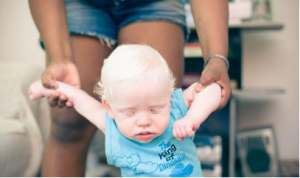Children with albinism are those with very fair skin, hair, eyebrows, and eyelashes that are very blonde, almost white, characteristics caused by a lack of melanin production in the tissues. Due to these very noticeable features, it is possible to identify if a child has albinism as soon as they are born. Albinism is not such a rare condition. It’s likely we have already encountered children and adults with albinism. What most people don’t know is what causes this condition and why it results in this absence of color in nearly the whole body. In this article, we will learn more about the characteristics of albinism, its causes, and the care needed for these children who may indeed be lighter-skinned than most, but who are simply children like any other. With the same dreams, abilities, and rights.
Main Characteristics of Albinism
Albinism is simply the lack of sufficient melanin production for the pigmentation of tissues such as the skin, hair, eyelashes, and eyebrows. That is why children with albinism have very fair skin and almost white-blonde hair1.
Eye Color
The eyes of people with albinism have affected coloration. They are usually blue or violet, but it is possible for children with albinism to have red or brown eyes. However, there are also children with albinism who have brown hair and eyes, but their skin is not so fair. And if these characteristics are similar to those of their parents and relatives, the condition may even go unnoticed.
Vision problems
Albinism can also affect the eyes. Children with albinism may have low vision problems that, in extreme cases, can even lead to blindness. This happens because of underdevelopment of the retina and problems with the optic nerve connection2. That’s why the ophthalmologist is one of the specialists who can contribute to a more accurate diagnosis of the condition.
More sensitive skin
Regarding the skin of a child with albinism, care must be taken to protect it from sun exposure. Because the skin is very white due to the lack of melanin, it is very sensitive and always needs to be protected. Covered with long clothing whenever possible and with plenty of sunscreen. All this protection is important for people with albinism, because they have a higher risk of developing skin cancer.
Types of albinism
In most cases, we can spot a child with albinism from afar, exactly because of the striking physical features. However, there are different types of albinism, classified according to the gene that mutated.
- Oculocutaneous albinism: when it affects pigmentation of the skin, hair, and eyes. Inside this type is the most severe form of albinism, where no melanin exists, and a more moderate form, when there is melanin but not enough of it.
- Partial albinism: In this type of albinism, the impact is on the eyes, hair, or skin. Or sometimes, only vision problems, which are typical for this condition.
What causes albinism and what are its symptoms?
Albinism is caused solely by a genetic mutation. It happens when several types of genes, which are specific in producing various proteins responsible for making melanin, are deficient. Melanin is a natural substance in our bodies, found in the skin, hair, and eyes. It is produced by cells called melanocytes. Failures in these cells can cause a complete lack of melanin or insufficient production, impacting pigmentation in these parts of the body and resulting in the well-known symptoms of albinism. It is common for babies with albinism to have little or no pigmentation in their eyebrows and eyelashes. Or for their first sign to be impaired vision. This usually happens around the third or fourth month of life.
Treatments recommended for children with albinism
We already know that albinism is nothing more than a genetic fault, and this makes treatment options more limited. Basically, the child with albinism should receive regular care for their skin and vision. Since albinism can cause eye problems, the ophthalmologist is an important specialist throughout the treatment process, which will be ongoing, aimed at detecting the evolution of any condition that may more seriously affect the patient’s vision. It is also important to perform regular exams to assess the progression of the impact on vision. People with albinism will likely need special eyeglass lenses and surgical procedures to ease symptoms of nystagmus and strabismus. Caring for the skin of a person with albinism is equally important3. Continuous and preventive monitoring is essential to detect any indication of skin lesions that can lead to skin cancer, which is one of the most serious complications of this condition. Albinism is not contagious, does not interfere with the patient’s life expectancy, and with proper medical follow-up to prevent any complications with vision or skin diseases, it is possible to have an excellent quality of life. See Also: Baby Eye Color – What Will It Be? Photo: Felipe Fernandes













